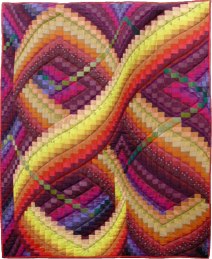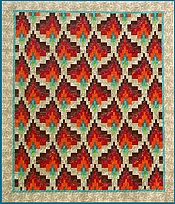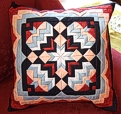Some time ago I received a message from one of my nieces. At her workplace they were about to throw away some older fabric samples, and she wondered if I could make use of some of them.

I happily accepted to take everything she got, and here is the lot, released from the books and cards they were fastened to. They were mostly curtains and upholstery fabrics, which are heavier than ordinary quilting fabrics, and with lots of interesting textures.


I chose this two tone twill weave to start with. After scrubbing away the paper backing, I cut off all the pinked edges, and made sure all the rectangles were exactly the same size. Then I separated the sample pieces into piles of dark, medium and light, and one pile with pieces that had a bit more colours in them than the beiges and greys which dominated the sample collection.



I arranged the three different piles in a 3 by 4 grid, and also put some of the coloured patches into the layout. The samples measured 12 by 16 cm, so each group layout ended up as a 48 cm square.


I drew a full scale simple pattern: a large circle touching the edges, with a smaller circle inside, then a large pie shape that intersected the two circles. Then I drew the mirrored pattern on three pieces of paper backed fusible web. I also drew the 3 by 4 grid, and the outer edges.

I turned the diffferent groups of samples upside down, and ironed the fusible web to the back side of the samples, taking care to line up the grid lines exactly between the patches.



I cut along the pattern lines, and then turned the pieces right side up, keeping the same groups for now.



Then I had some fun shifting the different pattern pieces from one group to another. I played around for a while till I was satisfied with the effect.


Then I removed the paper from the back of the pattern pieces and placed each group onto a fabric backing, taking care to line up the grid and pattern lines. Then they were ironed to the backing, and I could sew the patches down with a double zigzag stitch, using a dark grey thread.

I decided to make the panels into three cushions. The samples came with one fairly large piece in one of the beige colourways, so I used that to make zippered backings for the cushions.

And here they are, resting on the sofa.
🙂
Eldrid
Filed under: graphic, patchwork, quilt, sewing, textiles | Tagged: circles, cushions, fabric, fabric samples, fusible web, home decor, patchwork, pillows, quilt, texture, twill fabric, upholstery fabric | 2 Comments »


 KameleonquiltGallery of quiltsPatterns
KameleonquiltGallery of quiltsPatterns






























































































































































































































































